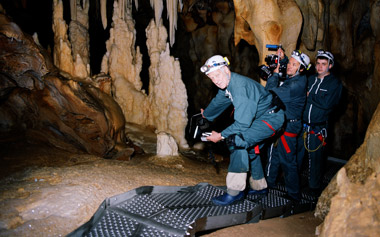Living in New England means living surrounded by history. It’s the sort of thing that becomes rather easy to overlook when, in the course of a day, you can breakfast at the home of the man who invented the Graham cracker (Sylvester’s in Northampton), take in some dinosaur tracks along Route 5 in Holyoke, and catch a show where Sarah Bernhardt and Harry Houdini once trod the boards (the Academy of Music, again in Northampton).
But there is history, and—dinosaur tracks notwithstanding—there is history. And for all the vast wonder of our United States, its earliest historical markers often seem to lack the dramatic human tinge of a Pompeii. No matter how tall a T. Rex might get, it will always be easier—and still more mysterious—to feel a connection to another person who lived out their life here on Earth.
This Friday, that mystery deepens when Cave of Forgotten Dreams opens at locations around the Valley. The work of idiosyncratic German filmmaker Werner Herzog (Encounters at the End of the World, Grizzly Man), this documentary offers a rare glimpse of a remarkable find: a collection of cave etchings that are estimated to be some of the oldest remnants of humankind ever discovered.
Discovered in 1994 at the Chauvet-Pont-d’Arc cave in southern France, the etchings and drawings—depictions of predatory animals mixed in with hand prints of the artists that drew them—are breathtaking. Moving beyond their obvious historical importance (more on that in a moment), they are simply great works of art, and they do what great works of art always do: they strike at some indefinable place within us, forging a connection between viewer and artist that seems to have always existed. Looking at them is a form of magic; see them, and you feel the same close atmosphere of the cave their creators must have felt.
Atmosphere, unfortunately, is something of a problem for Chauvet-Pont-d’Arc. After being so sheltered for so long, the paintings could be irreparably damaged by the changes brought in by explorers—even human breath was put on the watch list. Today, the cave is under permanent surveillance, and the rarely allowed visitor must wear a protective suit that has never come into contact with the exterior world. It seems a most unlikely candidate for the documentary treatment—film crews are not generally known for their delicacy. More amazing still is that when permission was granted, it was granted to Herzog, a director who once ate part of his shoe on camera.
But credit the French government for recognizing in Herzog not only the documentarian, but the artist. Filming with heat-free lights, Herzog is able to capture the textures and lines of the cave walls and the art that marks them, preserving what time and nature will inevitably destroy. But it’s Herzog the artist who teases out the questions of what these marks mean to us as humans, and what they say about our impulse to leave behind something more lasting than ourselves.
Cave of Forgotten Dreams opens May 20 at Pleasant Street Theater in Northampton, but may also be coming soon to Hadley’s Cinemark Theaters in a 3D presentation. Normally I’m not a huge proponent of 3D (and at press time, Cinemark couldn’t confirm film dates), but a film about cave exploration seems like the perfect opportunity to take a chance—for a film this good, why not see both?
*
Also this week: Potiche is screening at Amherst Cinema. Adapted from the ’70s-era comic play of the same name, this film version stars screen legend Catherine Deneuve as Suzanne Pujol, the trophy wife (“potiche”) of an umbrella factory magnate ( a nod, perhaps, to Deneuve’s most famous role, in The Umbrellas of Cherbourg). When her husband is taken hostage by his striking workers, Suzanne takes over the family business with surprising success. Gerard Depardieu co-stars as the ex-lover and union leader who still pines for Ms. Pujol. Directed by Francois Ozon (Swimming Pool, Under the Sand), Potiche is an updated satire of sexual warfare.
Jack Brown can be reached at cinemadope@gmail.com.



